
101
HUNG VUONG UNIVERSITY JOURNAL OF SCIENCE AND TECHNOLOGY Vol. 37, No. 4 (2024): 101 - 109
*Email: thanhnguyen.irrd.2021@gmail.com
TẠP CHÍ KHOA HỌC VÀ CÔNG NGHỆ
TRƯỜNG ĐẠI HỌC HÙNG VƯƠNG
Tập 37, Số 4 (2024): 101 - 109
HUNG VUONG UNIVERSITY
JOURNAL OF SCIENCE AND TECHNOLOGY
Vol. 37, No. 4 (2024): 101 - 109
Email: tapchikhoahoc@hvu.edu.vn Website: www.hvu.edu.vnjst.hvu.vn
ASSESSMENT OF THE STATUS OF COMMERCIAL CINNAMON
PRODUCTION AREAS ACCORDING TO ORGANIC STANDARDS
IN DAM HA DISTRICT, QUANG NINH PROVINCE
Nguyen Thi Thanh1*, Nguyen Kieu Mi1, Nguyen Dac Binh Minh1,
Tran Duc Thien1, Luong Van Truong1, Pham Duc Chinh1,
Nguyen Thi Viet Quynh1, Cao Hong Nhung1, Phan Thi Lan Anh1
1Institute of Regional Research and Development, Ministry of Science and Technology, Hanoi
Received: 16 November 2024; Revised: 29 November 2024; Accepted: 03 December 2024
DOI: https://doi.org/10.59775/1859-3968.227
Abstract
This study evaluates the current status and potential of cinnamon production regions in Vietnam that adhere to
organic standards in Dam Ha district, Quang Ninh province. Organic cinnamon production not only enhances
economic value but also contributes to environmental protection and ecological sustainability. However, the
development of organic cinnamon production areas faces many challenges due to unmet standard requirements.
This study aims to analyze the current status, identify challenges, and propose measures to improve the organic
production system for cinnamon. The research methods include field surveys, collecting soil and water samples
for analysis to evaluate heavy metal content and pesticide residues, and assessing buffer zones and cultivation
management processes. The study results show that 30 soil samples from representative areas have low heavy
metal content compared to Vietnamese standards (ranging from 2.15 to 34.25 mg/kg, while the maximum
permissible limit is 150 mg/kg). Analysis of 15 water samples also indicated that heavy metal content and
pesticide residues were within permissible limits.
Keywords: Cinnamon, organic production, Quang Ninh, standards, environmental conservation.
1. Introduction
Organic agriculture, with the goal of protecting
the health of soil, ecosystems, and people, is gaining
increasing attention. Studies show that organic
farming supports sustainability, positively impacts
the environment, and contributes to improving
the quality of life for all stakeholders involved
[1-3]. The fundamental principles of organic
agriculture include protecting ecosystem health,
respecting natural ecology, maintaining social
fairness, and careful management to ensure the
well-being of future generations [4]. Worldwide,
since 1972, the International Federation of
Organic Agriculture Movements (IFOAM) has
been promoting organic production by issuing
international standards and certifications. Organic
production has flourished, covering millions of
hectares of farmland and generating billions of
dollars in market value. According to IFOAM,
the development of organic agriculture can be
divided into three phases: the initial pioneering
stage, standardization and expansion, and more

102
HUNG VUONG UNIVERSITY JOURNAL OF SCIENCE AND TECHNOLOGY Nguyen Thi Thanh et al.
recently, optimization to enhance sustainability
and social equity [5-7].
Cinnamon is one of Vietnam’s essential
medicinal plants, primarily concentrated in
regions such as Yen Bai Province, Quang
Nam province (Tra Mi), Quang Ngai
province (Tra Bong), Nghe An province
(Que Phong), Thanh Hoa province (Thuong
Xuan), Lao Cai province (Bao Thang, Bao
Yen), Quang Ninh province (Dam Ha, Tien
Yen, Binh Lieu) and several other localities.
In Dam Ha district, Quang Ninh province,
with its favorable climate and soil conditions,
it has become one of the potential areas for
cinnamon cultivation. In the context of the
global market increasingly focusing on
organic agricultural products, transitioning
to organic cinnamon production not only
enhances product value but also meets the
growingly stringent demands of consumers,
particularly in export markets. However, the
current cinnamon cultivation practices in
Dam Ha still face many instabilities, such
as traditional production methods, limited
application of organic technical measures,
and a lack of uniform management and
monitoring standards.
Evaluating the state of commercial
cinnamon production in Dam Ha district under
organic production standards is essential to
identify advantages, challenges, and propose
appropriate solutions. The research results
will contribute to building a foundation for
developing a sustainable cinnamon-growing
region, not only meeting market demands but
also protecting the environment and improving
the income of local people.
2. Methods
The study was conducted in cinnamon
forest stands of two communes (Quang An
and Quang Lam) in Dam Ha districts, Quang
Ninh province.
- Soil samples were collected from Quang
An commune (An Son village, Na Thung
village, Coc Pac village, Tan Truc Tung
village, Na Pa village, and Na Cang village)
and Quang Lam commune (Tai Ly Say village,
Siec Long Min village, and Ly Pui area).
These locations represent the typical terrain
of various areas within Dam Ha district.
Therefore, we collected 30 representative
soil samples and 15 representative water
samples from the Dam Ha district area.
- Organizing the survey: The team consists
of five people, who will conduct a survey
of the cinnamon-growing area in Dam Ha
district within 10 days. The survey will cover
the following factors:
- Soil conditions in commercial Cinnamon
plantation areas: Cinnamon production
areas adhering to organic standards must be
surveyed and assessed to ensure compatibility
between actual production conditions and the
standards’ requirements regarding the risk
levels of chemical, biological, and physical
contamination affecting the product. Survey
the soil conditions at 30 samples (depth of
0-60 cm) wered collected to assess the heavy
metal contents including Arsenic (As),
Cadmium (Cd), Lead (Pb), Copper (Cu),
Zinc (Zn), Chromium (Cr), and pesticide
residues. The soil samples were analyzed
at the Institute of Regional research and
Development, Ministry of Science and
Technology, and the heavy metal content was
assessed following the current regulations of
the Vietnamese Standards [9-15].
- Water source: Analyze 15 irrigation
water samples were collected to assess the
heavy metal contents, including Mercury
(Hg), Arsenic (As), Lead (Pb), and pesticide
residues. The water source samples were
analyzed at the Institute of Regional Research
and Development, Ministry of Science and
Technology, and the heavy metal content was
assessed following the current regulations of
the Vietnamese Standards [16-20].
- Cinnamon variety: Verify the variety,
origin, and the process of producing seedlings
that organic standards.
- Management of cinnamon cultivation
process: Evaluate the irrigation water sources,

103
HUNG VUONG UNIVERSITY JOURNAL OF SCIENCE AND TECHNOLOGY Vol. 37, No. 4 (2024): 101 - 109
including physico-chemical indicators, to
meet organic farming requirements; assess the
use of fertilizers in compliance with organic
standards during production; inspect pest and
disease control measures, including the use
of plant protection products in the cultivation
areas; and evaluate the processes of harvesting,
transportation, and storage of cinnamon
products at the processing plant [21].
3. Results and Discussion
3.1. Soil conditions of the Cinnamon
cultivation area
The Cinnamon cultivation area, which
follows organic standards, was surveyed
and evaluated based on the regulations
related to chemical, biological, and physical
contamination of the products. The locations
for collecting representative soil samples for
the area are shown in table 1.
Table 1. Representative locations of soil samples in Dam Ha district
CODE Address Coordinates
Ethnic group Hamlet X Y
1Đ.QA.AS.01.19102022 Chiu Di Sau An Son 747362 2367111
2Đ.QA.NP.02.19102022 Tran Van Lau Na Thung 761498 2366514
3Đ.QA.CP.03.19102022 Chiu Di Phu Coc Pac 760962 2366497
4Đ.QA.CP.04.19102022 Hoang Chi Coc Pac 760851 2366415
5Đ.QA.CP.05.19102022 Ly Soi Tenh Coc Pac 760557 2366569
6Đ.QA.CP.06.19102022 Voong Sang Hen Coc Pac 760334 2366552
7Đ.QA.CP.07.19102022 Senh A Sang Coc Pac 760312 2366576
8Đ.QA.CP.08.19102022 Ly Dong Vay Coc Pac 760376 2366598
9Đ.QA.TTT.09.19102022 Ly A Sat Tan Truc Tung 758638 2366711
10 Đ.QA.TTT.10.19102022 Lenh Cam Sang Tan Truc Tung 759111 2367075
11 Đ.QA.TTT.11.19102022 Ho Thenh Phat Tan Truc Tung 759208 2367151
12 Đ.QA.TTT.12.19102022 Ly Van Thenh Tan Truc Tung 756084 2367795
13 Đ.QA.TTT.13.19102022 Ly A Tai Tan Truc Tung 760897 2368009
14 Đ.QA.NP.14.19102022 Ly Van Tac Na Pa 760307 2368323
15 Đ.QA.NP.15.19102022 Ly A Nhi Na Pa 760115 2368377
16 Đ.QA.NP.16.19102022 Ly Van Thong Na Pa 760067 2368413
17 Đ.QA.NP.17.19102022 Ly Van Senh Na Pa 759997 2368494
18 Đ.QA.NP.18.19102022 Ly Say Pan Na Pa 759897 2368602
19 Đ.QA.NP.19.19102022 Ly Say Nip Na Pa 759805 2368583
20 Đ.QA.NP.20.19102022 Lenh A Ma Na Pa 759850 2369420
21 Đ.QA.NP.21.19102022 Chiu Quay Senh Na Pa 759971 2369556
22 Đ.QA.NP.22.19102022 Che Thu Sang Na Pa 759506 2369700
23 Đ.QA.NC.23.19102022 Chiu Sang Phat Na Cang 761607 2367860
24 Đ.QA.NC.24.19102022 Chiu Cam Phu Na Cang 762103 2368021
25 Đ.QA.NC.25.19102022 Senh Hy Chong Na Cang 762075 2367666
26 Đ.QL.TLS.26.19102022 Chiu Chan Hy Tai Ly Say 756606 2369510
27 Đ.QL.SLM.27.19102022 Chiu Di Lenh Siec Long Min 765808 2376424
28 Đ.QL.SLM.28.19102022 Chiu Di Lenh Siec Long Min 765848 2376499
29 Đ.QL.TLS.29.19102022 La A Tai Tai Ly Say 767635 2370432
30 Đ.QL.TLS.30.19102022 Chiu Cam Nam Tai Ly Say 767724 2370064
The analysis results of 30 soil samples
show that the levels of metals and pesticide
residues are all within the permissible
limits:
- Cu (Copper): Ranges from 2.15 mg/kg
(sample Đ.QA.AS.01.19102022) to 34.25
mg/kg (sample Đ.QA.NP.19.19102022),
below the maximum limit of 150 mg/kg.

104
HUNG VUONG UNIVERSITY JOURNAL OF SCIENCE AND TECHNOLOGY Nguyen Thi Thanh et al.
Zn (Zinc): Ranges from 1.6 mg/kg
(sample Đ.QL.TLS.30.19102022) to 43.6
mg/kg (sample Đ.QA.CP.03.19102022),
below the maximum limit of 200 mg/kg.
- Cr (Chromium), Cd (Cadmium), Pb
(Lead), As (Arsenic): All samples are well
below the maximum limits of 200 mg/
kg, 3 mg/kg, 100 mg/kg, and 20 mg/kg,
respectively.
Pesticides: Residues of organic and
organophosphate groups are below the limits
of 0.1 mg/kg and 0.05 mg/kg.
- For the residues of organochlorine and
organophosphate pesticides, the permissible
limits are 0.1 mg/kg in dry soil of the topsoil
layer and 0.05 mg/kg in dry soil of the
topsoil layer. The results show that all 30 soil
samples are within the permissible limits for
pesticide residues.
Table 2. Soil analysis results and comparison with Vietnamese standards (Unit: mg/kg dry soil)
No. CODE Copper Zinc Chromium Cadmium Lead Arsenic
Lindan,
Endosulfan 1,
Endosulfan 2,
Endrin, Dieldrin
Diazinon,
merphos,
disulfoton,
dimethoate,
chlorpyrifos,
profenofos
Allowable limits 150 200 200 3 100 20 0.01 0.05
1Đ.QA.
AS.01.19102022 2.15 2 4.1 KHP
(LOD = 0.0045) 1.84 2.23 KPH
( LOD = 0.002)
KPH
( LOD = 0.02)
2Đ.QA.
NP.02.19102022 3.65 10.5 6.1 KHP
(LOD = 0.0045) 7.33 0.90 KPH
( LOD = 0.002)
KPH
( LOD = 0.02)
3Đ.QA.
CP.03.19102022 28.25 43.6 5 KHP
(LOD = 0.0045) 2.08 4.44 KPH
( LOD = 0.002)
KPH
( LOD = 0.02)
4Đ.QA.
CP.04.19102022 19.55 11.3 4.2 KHP
(LOD = 0.0045)
KPH
(LOD = 0.042) 0.49 KPH
( LOD = 0.002)
KPH
( LOD = 0.02)
5Đ.QA.
CP.05.19102022 14.75 21.2 12.4 KHP
(LOD = 0.0045)
KPH
(LOD = 0.042) 0.28 KPH
( LOD = 0.002)
KPH
( LOD = 0.02)
6Đ.QA.
CP.06.19102022 17.25 12.9 7.8 KHP
(LOD = 0.0045)
KPH
(LOD = 0.042) 0.58 KPH
( LOD = 0.002)
KPH
( LOD = 0.02)
7Đ.QA.
CP.07.19102022 8.15 9.8 9.8 KHP
(LOD = 0.0045)
KPH
(LOD = 0.042) 1.60 KPH
( LOD = 0.002)
KPH
( LOD = 0.02)
8Đ.QA.
CP.08.19102022 10.95 12.6 7.5 KHP
(LOD = 0.0045)
KPH
(LOD = 0.042) 1.19 KPH
( LOD = 0.002)
KPH
( LOD = 0.02)
9Đ.QA.
TTT.09.19102022 18.05 2.7 8.3 KHP
(LOD = 0.0045)
KPH
(LOD = 0.042) 10.79 KPH
( LOD = 0.002)
KPH
( LOD = 0.02)
10 Đ.QA.
TTT.10.19102022 20.65 13 11.9 KHP
(LOD = 0.0045) 39.13 6.74 KPH
( LOD = 0.002)
KPH
( LOD = 0.02)
11 Đ.QA.
TTT.11.19102022 27.65 12.2 17.1 KHP
(LOD = 0.0045) 15.07 8.17 KPH
( LOD = 0.002)
KPH
( LOD = 0.02)
12 Đ.QA.
TTT.12.19102022 21.45 10.3 14.5 KHP
(LOD = 0.0045) 50.92 6.56 KPH
( LOD = 0.002)
KPH
( LOD = 0.02)
13 Đ.QA.
TTT.13.19102022 19.85 11.2 10 KHP
(LOD = 0.0045) 71.14 5.44 KPH
( LOD = 0.002)
KPH
( LOD = 0.02)
14 Đ.QA.
NP.14.19102022 13.25 9.6 15.7 KHP
(LOD = 0.0045) 24.08 2.59 KPH
( LOD = 0.002)
KPH
( LOD = 0.02)
15 Đ.QA.
NP.15.19102022 19.05 11.8 13.5 KHP
(LOD = 0.0045) 15.46 5.75 KPH
( LOD = 0.002)
KPH
( LOD = 0.02)
16 Đ.QA.
NP.16.19102022 24.05 10.4 14.6 KHP
(LOD = 0.0045) 22.67 6.05 KPH
( LOD = 0.002)
KPH
( LOD = 0.02)
17 Đ.QA.
NP.17.19102022 16.05 5.1 10.8 KHP
(LOD = 0.0045) 1.09 3.26 KPH
( LOD = 0.002)
KPH
( LOD = 0.02)
18 Đ.QA.
NP.18.19102022 17.95 12.7 8.1 KHP
(LOD = 0.0045) 19.73 4.02 KPH
( LOD = 0.002)
KPH
( LOD = 0.02)
19 Đ.QA.
NP.19.19102022 34.25 6.1 6.6 KHP
(LOD = 0.0045) 21.65 3.80 KPH
( LOD = 0.002)
KPH
( LOD = 0.02)
20 Đ.QA.
NP.20.19102022 8.65 3.2 8.9 KHP
(LOD = 0.0045) 49.79 1.85 KPH
( LOD = 0.002)
KPH
( LOD = 0.02)
21 Đ.QA.
NP.21.19102022 12.55 2.2 7.5 KHP
(LOD = 0.0045) 43.50 6.57 KPH
( LOD = 0.002)
KPH
( LOD = 0.02)
22 Đ.QA.
NP.22.19102022 25.45 34.5 2.7 KHP
(LOD = 0.0045) 17.20 4.51 KPH
( LOD = 0.002)
KPH
( LOD = 0.02)

105
HUNG VUONG UNIVERSITY JOURNAL OF SCIENCE AND TECHNOLOGY Vol. 37, No. 4 (2024): 101 - 109
No. CODE Copper Zinc Chromium Cadmium Lead Arsenic
Lindan,
Endosulfan 1,
Endosulfan 2,
Endrin, Dieldrin
Diazinon,
merphos,
disulfoton,
dimethoate,
chlorpyrifos,
profenofos
23 Đ.QA.
NC.23.19102022 10.55 7.4 6.9 KHP
(LOD = 0.0045) 56.28 3.41 KPH
( LOD = 0.002)
KPH
( LOD = 0.02)
24 Đ.QA.
NC.24.19102022 12.45 11.6 7.8 KHP
(LOD = 0.0045)
KPH
(LOD = 0.042) 0.64 KPH
( LOD = 0.002)
KPH
( LOD = 0.02)
25 Đ.QA.
NC.25.19102022 7.65 12 2.9 KHP
(LOD = 0.0045) 46.47 1.05 KPH
( LOD = 0.002)
KPH
( LOD = 0.02)
26 Đ.QL.
TLS.26.19102022 11.85 6.8 6.5 KHP
(LOD = 0.0045) 68.67 4.64 KPH
( LOD = 0.002)
KPH
( LOD = 0.02)
27 Đ.QL.
SLM.27.19102022 10.05 10.2 2.4 KHP
(LOD = 0.0045) 39.17 0.66 KPH
( LOD = 0.002)
KPH
( LOD = 0.02)
28 Đ.QL.
SLM.28.19102022 16.25 25.2 3.3 KHP
(LOD = 0.0045) 16.95 1.71 KPH
( LOD = 0.002)
KPH
( LOD = 0.02)
29 Đ.QL.
TLS.29.19102022 21.25 5.9 4.9 KHP
(LOD = 0.0045) 13.57 0.66 KPH
( LOD = 0.002)
KPH
( LOD = 0.02)
30 Đ.QL.
TLS.30.19102022 10.45 1.6 2.8 KHP
(LOD = 0.0045) 58.08 1.66 KPH
( LOD = 0.002)
KPH
( LOD = 0.02)
Footnote:
KPH – Not detection
LOD – Limit of Detection
The soil analysis results show that the
samples from the field sites exhibit heavy
metal levels of Arsenic (As), Cadmium (Cd),
Copper (Cu), Lead (Pb), Zinc (Zn), and
Chromium (Cr) in the surface soil layer, all
of which are lower than the standards set by
QCVN 03-MT:2015/BTNMT. Therefore,
the soil in Dam Ha district, Quang Ninh
province, is suitable for organic cinnamon
production.
3.2. Water conditions of the Cinnamon
cultivation area
The Cinnamon production area applying
organic standards was surveyed and
evaluated with the regulations of the standard
for the level of chemical, biological and
physical pollution on the product. Therefore,
in the organic Cinnamon production area, we
collected 15 water samples. The locations of
the representative soil samples for the area
are shown in Table 3.
Table 3. Representative locations of water samples in Dam Ha district
No. CODE Address Coordinates
Ethnic Name Hamlet Longitude Latitude
1ĐH_17_1 Ho Thenh Phat Coc Pac 761498 236495
2ĐH_17_2 Ly Van Thenh Coc Pac 760557 2366569
3ĐH_17_5 Ly A Tai Na Cang 758638 2366711
4ĐH_17_3 Ly Van Tac Na Pa 759805 2368583
5ĐH_17_4 Ly A Nhi Na Cang 761607 2367860
6ĐH_18_6 Ly Van Thong Mao San Cau 760067 2368413
7ĐH_18_8 Ly Van Senh Mao San Cau 767635 2370432
8ĐH_18_10 Ly Say Pan Na Cang 758638 2366711
9ĐH_18_12 Ly Say Nip Na Cang 759805 2368583
10 ĐH_18_11 Lenh A Ma Na Cang 759850 2369420
11 ĐH_18_13 Chiu Quay Senh Siec Long Min 765808 2376424
12 ĐH_18_9 Che Thu Sang Siec Long Min 765848 2376499
13 ĐH_18_7 Chiu Cam Nam Tai Ly Say 756606 2369510
14 ĐH_18_15 Chiu Sang Phat Tai Ly Say 765808 2376424
15 ĐH_18_14 Chiu Cam Phu Tai Ly Say 765848 2376499

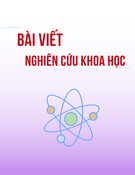




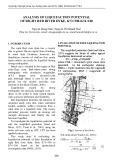
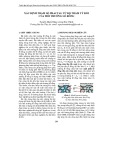

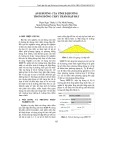
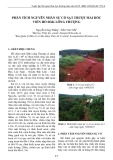

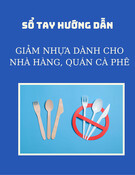
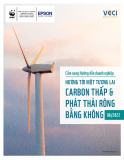


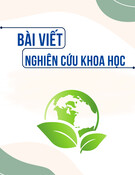




![Ô nhiễm không khí từ nông nghiệp: Thách thức toàn cầu và định hướng hành động [Mới nhất]](https://cdn.tailieu.vn/images/document/thumbnail/2025/20250917/kimphuong1001/135x160/52891758099584.jpg)




